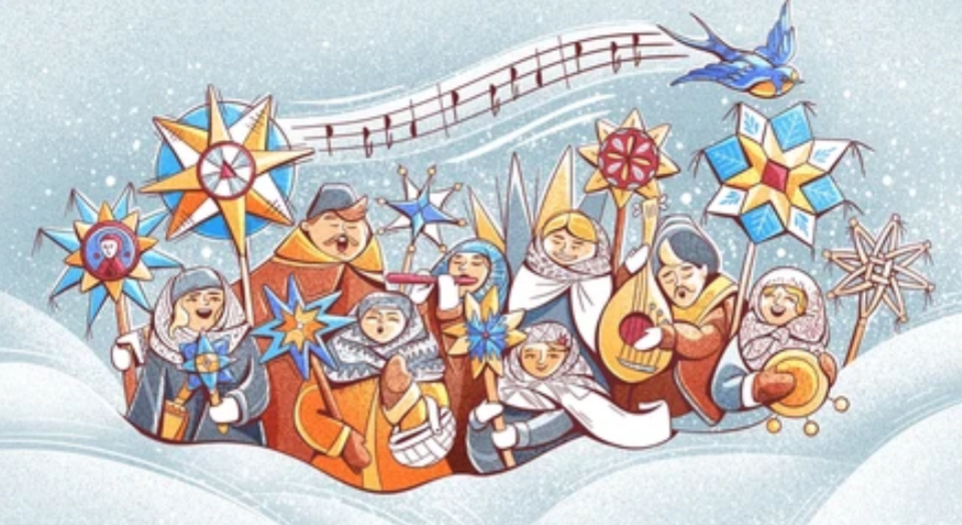By Mariia Bublykova, Year 12
Every year, as Christmas approaches and the colorful decorations start appearing on the streets, the very same, classic Christmas songs can be heard playing wherever you go. Whether it’s in the supermarket, on TV or someone humming the melody whilst on the tram. Among the variety of Christmas songs ever composed, one of the most recognizable will always be Carol of The Bells, making us wonder about its origins. Where does it come from? How did it appear and become so tightly associated with the Christmas spirit worldwide? Well, keep reading to find out.
This song, which we all love and appreciate today, in the 21st century, dates back to more than a hundred years ago, when it was created by Ukrainian composer Mykola Leontovych in 1914.
To many’s surprise, the song originally had the title “Shchedryk” roughly translating to “Bountiful evening”. Its creation had been strongly inspired by a homonymous folk song the composer discovered on one of his numerous folklore expeditions, a common and quite popular practice among the Ukrainian composers of that era. The production process wasn’t fast, it took approximately a decade after discovering the original melody, for Shedryk to finally be ready to be sung in a choir. It was first presented to the public on the 29th December 1916, at a Christmas concert in the hall of the Merchants Council building (today’s National Philharmonic Orchestra of Ukraine). The song was met with immediate success in the country, with various concerts featuring the new song taking place all over the capital, and other major cities.
These good times did not last long, as in October 1917, the Bolsheviks seized power in Moscow. War began against new states formed on the territory of the former Russian Empire. During the few short years of existence of the Ukrainian People’s Republic (1917/1918-1921), Ukrainian culture finally got to experience appreciation and promotion within its newly formed country. The Ukrainian language was promoted after being forbidden for hundreds of years, books in Ukrainian were getting published, and Ukrainian schools and national choirs were founded, leading to Mykola Leontovych, as well as many other Ukrainian composers and musicians, being invited to work for the music department of the Ukrainian Ministry of Education and Arts. This would have been unimaginable and labelled as a manifestation of “separatism” during the times of Tsarist Russia. In 1919, just as the Russian army was approaching the capital, Mykola Leontovych was approached with an offer of having his songs included in the European choir tour, a government-initiated project featuring the best singers across Ukraine. Yet, the composer well-known for his modesty, declined, “My songs are so badly composed that they cannot be sung on a Prague or Paris stage”. Having no time to persuade the composer, the chorist took his works without his permission, leaving the country. The very next day, the Russian army forces entered Kyiv, and upon the fear of facing persecution, Mykola Leontovych was forced to flee the capital. Years later, he was shot by an agent of the Bolshevik’s “secret police” while visiting his parents during the Orthodox celebration of Christmas. Meanwhile, the choir, under the lead of Oleksandr Koshyts, opened their tour in Prague, on 11 May 1919. After the successful performances in Czechoslovakia, the choir performed in Austria, France, and Switzerland. Receiving praise from the general public, as well as other musicians, politicians or critics.
(Ukrainian choir together with the head of the diplomatic mission of the UPR Mykola Vasylko in Bern, Switzerland, 1919)
Over the next 2 years, the Ukrainian National Chorus performed hundreds of concerts in 45 cities in 10 European countries, and first presented in the US in 1922 in New York. It was only in 1936, that an American composer named Peter Wilhousky wrote new lyrics in English. Adapting it to fit into the Western Christmas traditions and changing the title to “Carol Of The Bells”.
Just like that, over the last one hundred years, the now iconic Christmas song was brought to life, evolving from a local folk song, to a major hit, known and loved worldwide.



